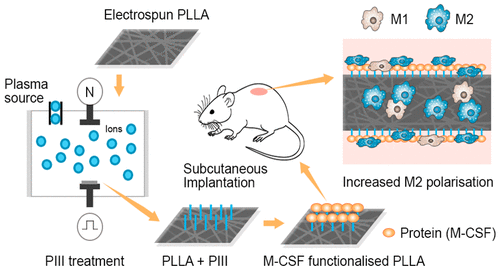当前位置:
X-MOL 学术
›
ACS Biomater. Sci. Eng.
›
论文详情
Our official English website, www.x-mol.net, welcomes your
feedback! (Note: you will need to create a separate account there.)
Immobilized Macrophage Colony-Stimulating Factor (M-CSF) Regulates the Foreign Body Response to Implanted Materials
ACS Biomaterials Science & Engineering ( IF 5.4 ) Pub Date : 2020-01-13 , DOI: 10.1021/acsbiomaterials.9b01887 Nianji Yang 1, 2, 3, 4 , Richard P. Tan 2, 3, 4 , Alex H. P. Chan 3 , Bob S. L. Lee 2, 3, 4 , Miguel Santos 2, 3, 4 , Juichien Hung 2, 3, 4 , Yun Liao 5 , Marcela M. M. Bilek 4, 6 , Jian Fei 7, 8 , Steven G. Wise 2, 3, 4 , Shisan Bao 1, 4
ACS Biomaterials Science & Engineering ( IF 5.4 ) Pub Date : 2020-01-13 , DOI: 10.1021/acsbiomaterials.9b01887 Nianji Yang 1, 2, 3, 4 , Richard P. Tan 2, 3, 4 , Alex H. P. Chan 3 , Bob S. L. Lee 2, 3, 4 , Miguel Santos 2, 3, 4 , Juichien Hung 2, 3, 4 , Yun Liao 5 , Marcela M. M. Bilek 4, 6 , Jian Fei 7, 8 , Steven G. Wise 2, 3, 4 , Shisan Bao 1, 4
Affiliation

|
The functionality and durability of implanted biomaterials are often compromised by an exaggerated foreign body reaction (FBR). M1/M2 polarization of macrophages is a critical regulator of scaffold-induced FBR. Macrophage colony-stimulating factor (M-CSF), a hematopoietic growth factor, induces macrophages into an M2-like polarized state, leading to immunoregulation and promoting tissue repair. In the present study, we explored the immunomodulatory effects of surface bound M-CSF on poly-l-lactic acid (PLLA)-induced FBR. M-CSF was immobilized on the surface of PLLA via plasma immersion ion implantation (PIII). M-CSF functionalized PLLA, PLLA-only, and PLLA+PIII were assessed in an IL-1β luciferase reporter mouse to detect real-time levels of IL-1β expression, reflecting acute inflammation in vivo. Additionally, these different treated scaffolds were implanted subcutaneously into wild-type mice to explore the effect of M-CSF in polarization of M2-like macrophages (CD68+/CD206+), related cytokines (pro-inflammatory: IL-1β, TNF and MCP-1; anti-inflammatory: IL-10 and TGF-β), and angiogenesis (CD31) by immunofluorescent staining. Our data demonstrated that IL-1β activity in M-CSF functionalized scaffolds was ∼50% reduced compared to PLLA-only at day 1 (p < 0.01) and day 2 (p < 0.05) post-implantation. There were >2.6-fold more CD206+ macrophages in M-CSF functionalized PLLA compared to PLLA-only at day 7 (p < 0.001), along with higher levels of IL-10 at both day 7 (p < 0.05) and day 14 (p < 0.01), and TGF-β at day 3 (p < 0.05), day 7 (p < 0.05), and day 14 (p < 0.001). Lower levels of pro-inflammatory cytokines were also detected in M-CSF functionalized PLLA in the early phase of the immune response compared to PLLA-only: a ∼58% decrease at day 3 in IL-1β; a ∼91% decrease at day 3 and a ∼66% decrease at day 7 in TNF; and a ∼60% decrease at day 7 in MCP-1. Moreover, enhanced angiogenesis inside and on/near the scaffold was observed in M-CSF functionalized PLLA compared to PLLA-only at day 3 (p < 0.05) and day 7 (p < 0.05), respectively. Overall, M-CSF functionalized PLLA enhanced CD206+ macrophage polarization and angiogenesis, consistent with lower levels of pro-inflammatory cytokines and higher levels of anti-inflammatory cytokines in early stages of the host response, indicating potential immunoregulatory functions on the local environment.
中文翻译:

固定化巨噬细胞集落刺激因子(M-CSF)调节异物对植入材料的反应
植入的生物材料的功能性和耐用性通常会因夸张的异物反应(FBR)而受损。巨噬细胞的M1 / M2极化是支架诱导的FBR的关键调节因子。造血生长因子巨噬细胞集落刺激因子(M-CSF)诱导巨噬细胞进入M2样极化状态,从而导致免疫调节并促进组织修复。在本研究中,我们探索表面的免疫调节作用结合在聚M-CSF升乳酸(PLLA)诱导FBR。通过等离子浸入离子注入(PIII)将M-CSF固定在PLLA的表面上。在IL-1β荧光素酶报告基因小鼠中评估了M-CSF功能化的PLLA,仅PLLA和PLLA + PIII,以检测IL-1β表达的实时水平,反映体内急性炎症。此外,将这些不同的处理过的支架皮下植入野生型小鼠中,以研究M-CSF对M2样巨噬细胞(CD68 + / CD206 +),相关细胞因子(促炎性因子:IL-1β,TNF和MCP-1;抗炎:IL-10和TGF-β),以及通过免疫荧光染色进行的血管生成(CD31)。我们的数据表明,在植入后第1天(p <0.01)和第2天(p <0.05),与仅PLLA相比,M-CSF功能化支架中的IL-1β活性降低了约50%。有>在M-CSF官能PLLA 2.6倍的CD206 +巨噬细胞相比,PLLA-仅在第7天(p在两个第7天(<0.001),具有较高水平的IL-10的沿p<0.05)和第14天(p <0.01),以及TGF-β在第3天(p <0.05),第7天(p <0.05)和第14天(p <0.001)。在免疫应答的早期阶段,在M-CSF功能化的PLLA中也检测到了较低的促炎细胞因子水平,与仅使用PLLA的情况相比:IL-1β在第3天降低了约58%。TNF在第3天下降约91%,在第7天下降约66%;而MCP-1在第7天下降了约60%。此外,血管生成增强内和/近在M-CSF官能PLLA观察支架相比PLLA-仅在第3天(p <0.05)和7天(p<0.05)。总体而言,M-CSF功能化的PLLA增强了CD206 +巨噬细胞极化和血管生成,与宿主反应早期阶段较低的促炎细胞因子水平和较高的抗炎细胞因子水平相一致,表明在局部环境中具有潜在的免疫调节功能。
更新日期:2020-01-13
中文翻译:

固定化巨噬细胞集落刺激因子(M-CSF)调节异物对植入材料的反应
植入的生物材料的功能性和耐用性通常会因夸张的异物反应(FBR)而受损。巨噬细胞的M1 / M2极化是支架诱导的FBR的关键调节因子。造血生长因子巨噬细胞集落刺激因子(M-CSF)诱导巨噬细胞进入M2样极化状态,从而导致免疫调节并促进组织修复。在本研究中,我们探索表面的免疫调节作用结合在聚M-CSF升乳酸(PLLA)诱导FBR。通过等离子浸入离子注入(PIII)将M-CSF固定在PLLA的表面上。在IL-1β荧光素酶报告基因小鼠中评估了M-CSF功能化的PLLA,仅PLLA和PLLA + PIII,以检测IL-1β表达的实时水平,反映体内急性炎症。此外,将这些不同的处理过的支架皮下植入野生型小鼠中,以研究M-CSF对M2样巨噬细胞(CD68 + / CD206 +),相关细胞因子(促炎性因子:IL-1β,TNF和MCP-1;抗炎:IL-10和TGF-β),以及通过免疫荧光染色进行的血管生成(CD31)。我们的数据表明,在植入后第1天(p <0.01)和第2天(p <0.05),与仅PLLA相比,M-CSF功能化支架中的IL-1β活性降低了约50%。有>在M-CSF官能PLLA 2.6倍的CD206 +巨噬细胞相比,PLLA-仅在第7天(p在两个第7天(<0.001),具有较高水平的IL-10的沿p<0.05)和第14天(p <0.01),以及TGF-β在第3天(p <0.05),第7天(p <0.05)和第14天(p <0.001)。在免疫应答的早期阶段,在M-CSF功能化的PLLA中也检测到了较低的促炎细胞因子水平,与仅使用PLLA的情况相比:IL-1β在第3天降低了约58%。TNF在第3天下降约91%,在第7天下降约66%;而MCP-1在第7天下降了约60%。此外,血管生成增强内和/近在M-CSF官能PLLA观察支架相比PLLA-仅在第3天(p <0.05)和7天(p<0.05)。总体而言,M-CSF功能化的PLLA增强了CD206 +巨噬细胞极化和血管生成,与宿主反应早期阶段较低的促炎细胞因子水平和较高的抗炎细胞因子水平相一致,表明在局部环境中具有潜在的免疫调节功能。










































 京公网安备 11010802027423号
京公网安备 11010802027423号